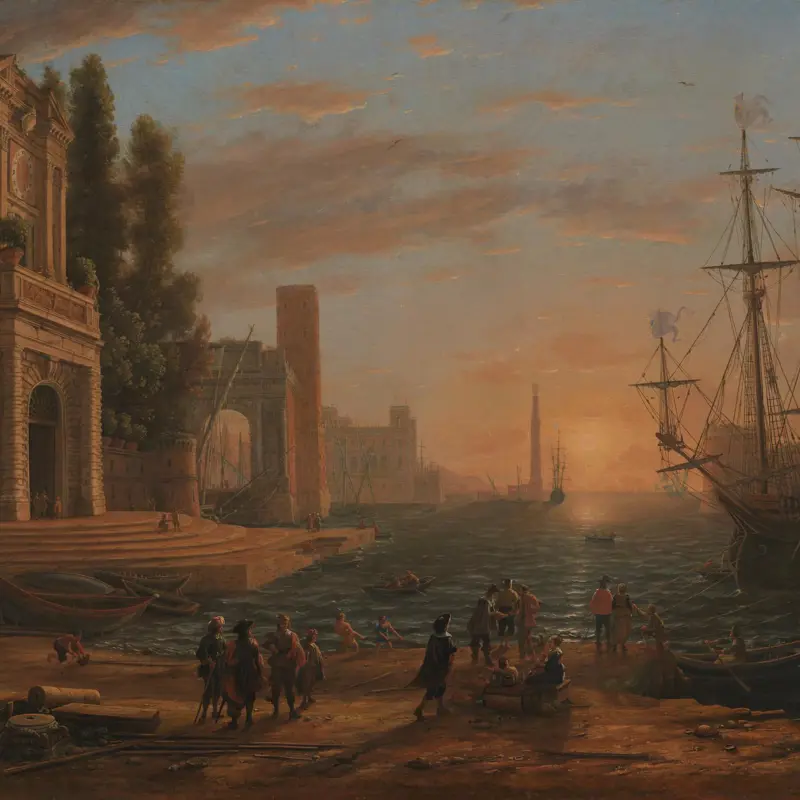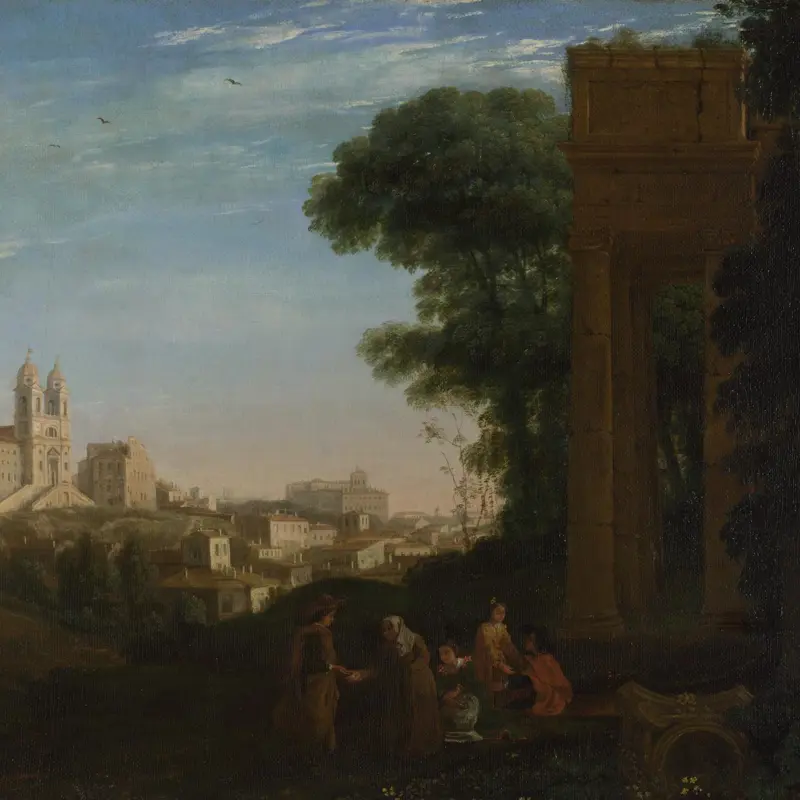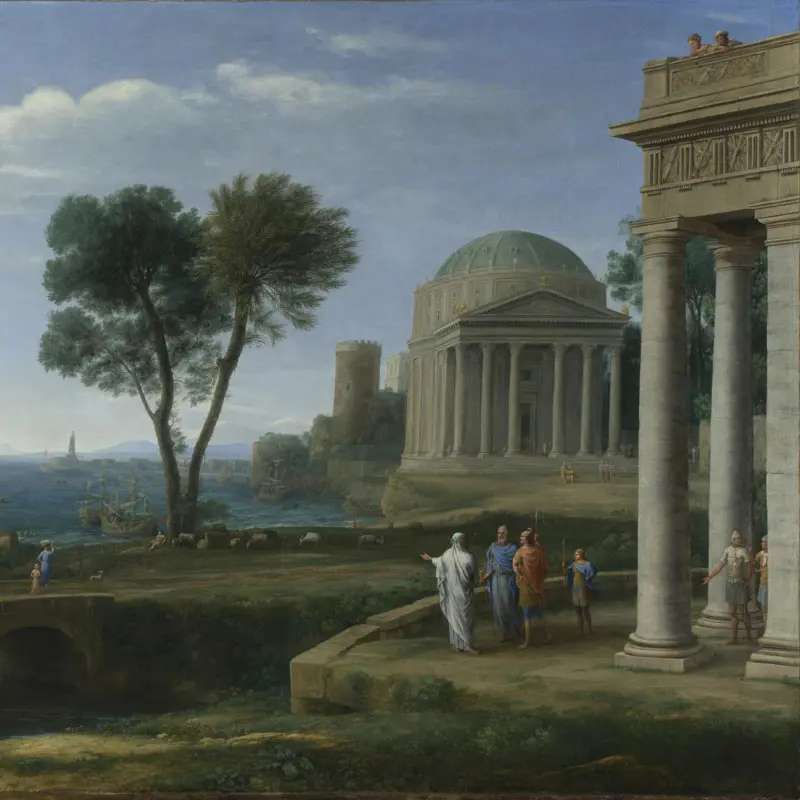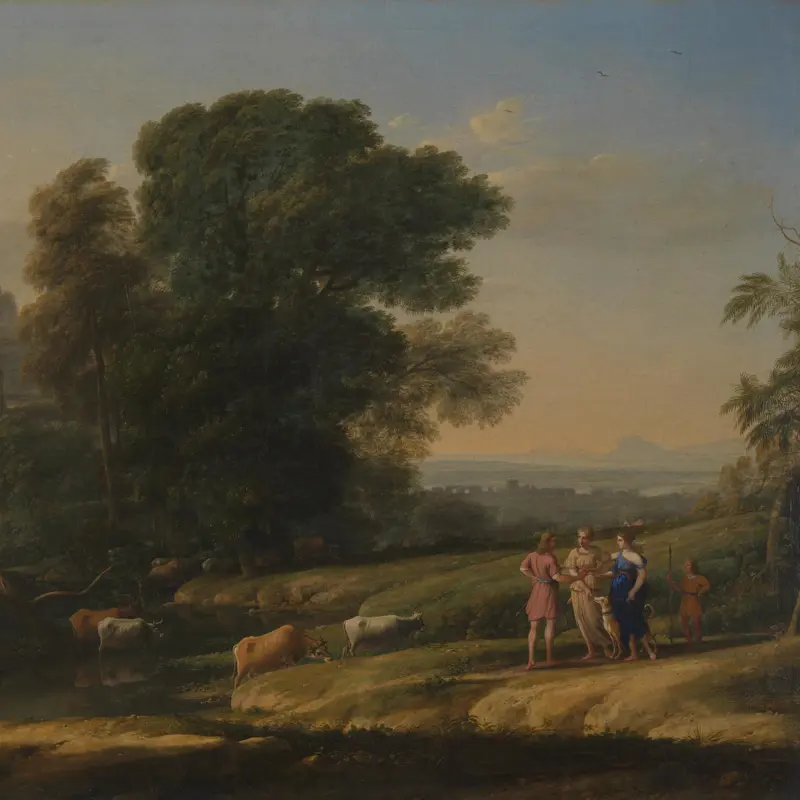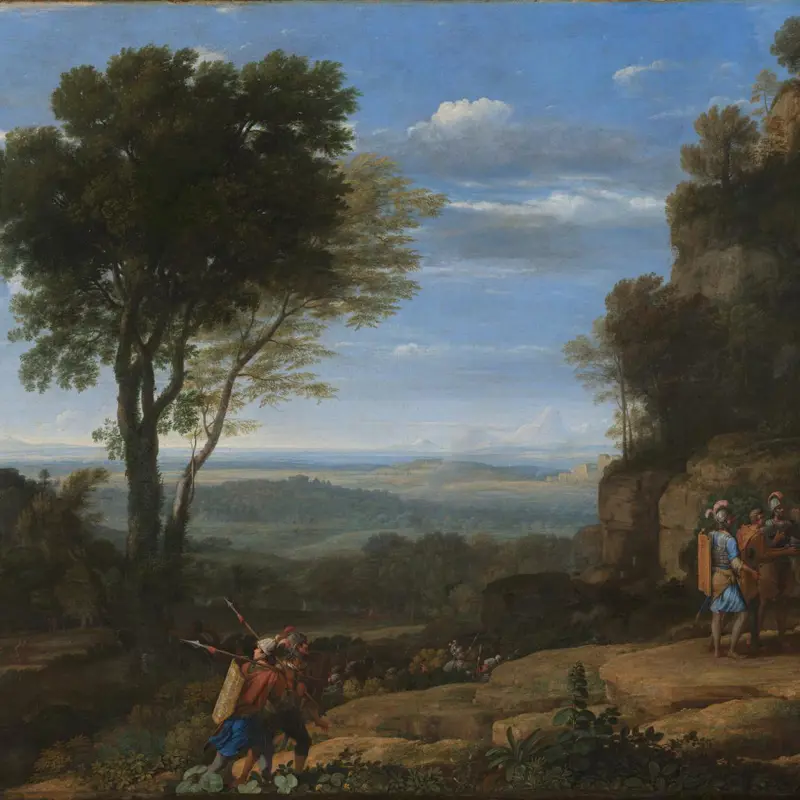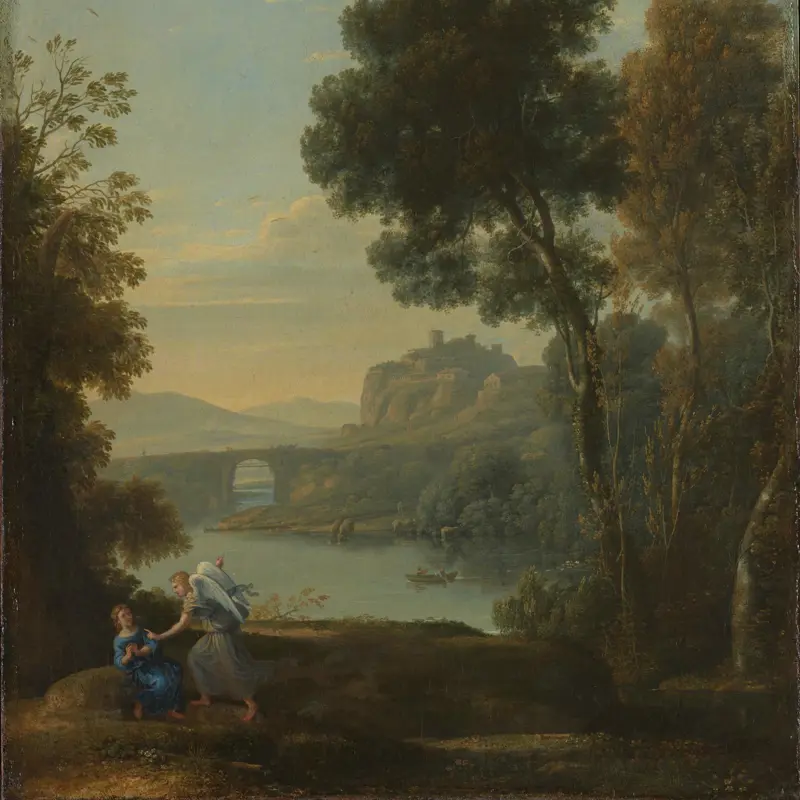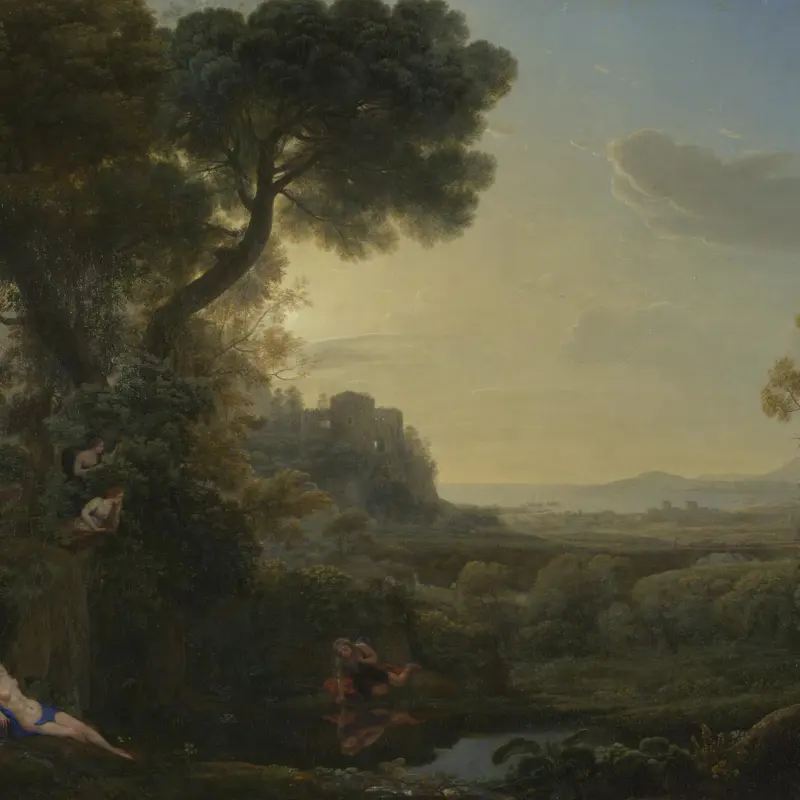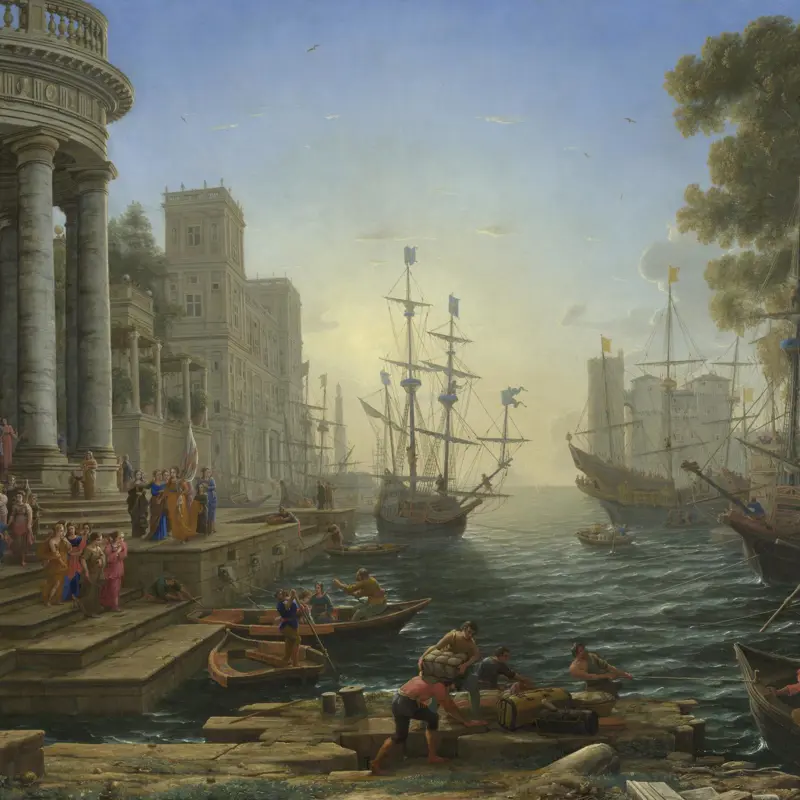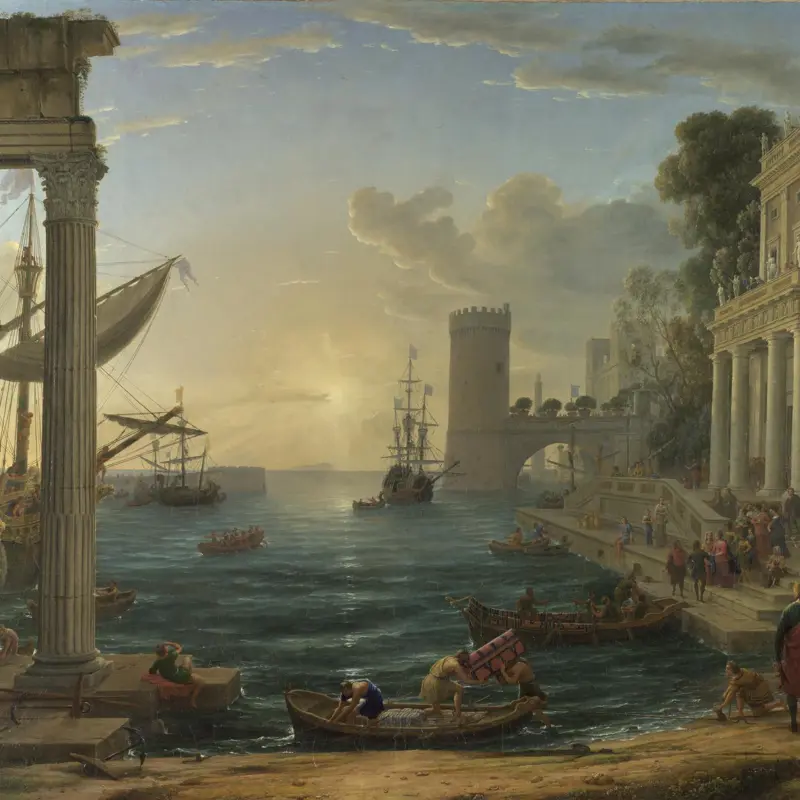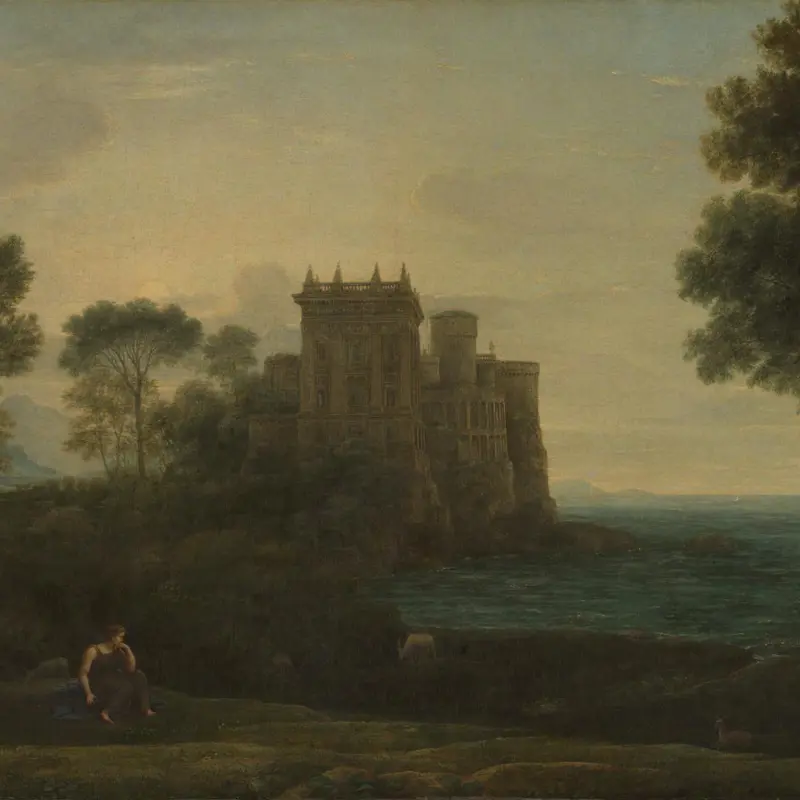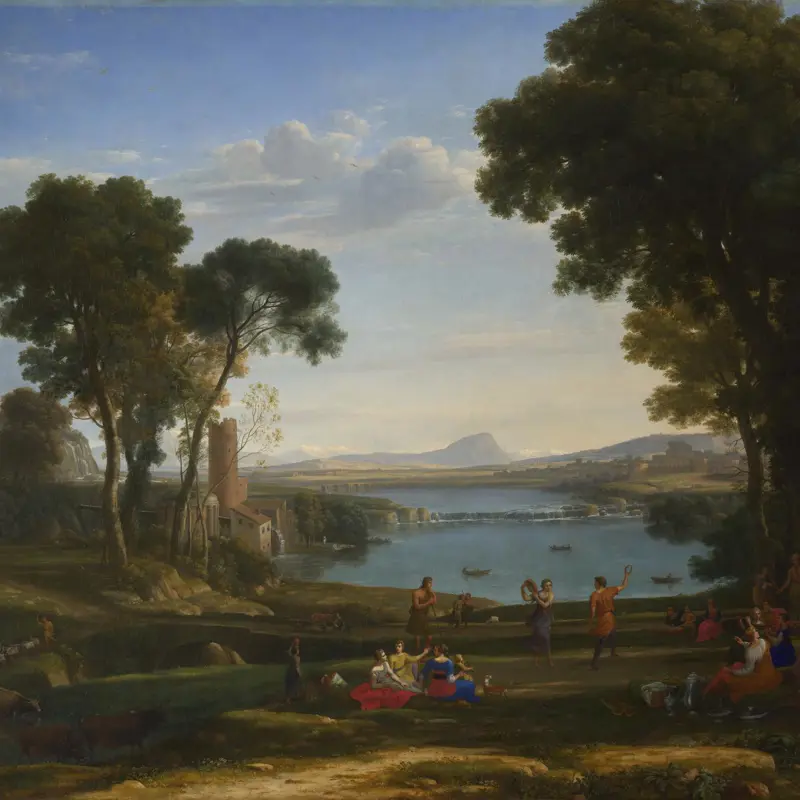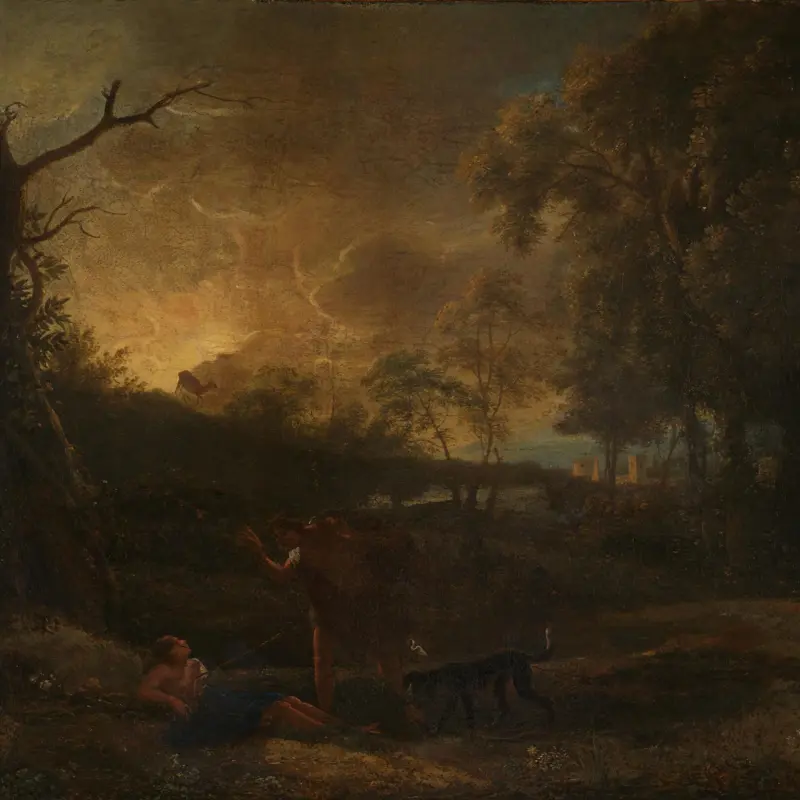Claude, 'Landscape with a Goatherd and Goats', about 1636-7
About the work
Overview
This small painting beautifully evokes the lushness of the natural world. A young man rests against the base of a tree and turns his head towards us. He holds one hand to his mouth as if playing a flute just out of view, a pose derived from images of the classical hero Orpheus charming the animals with his music. In classical art and literature, the shepherd or goatherd was often a symbol of a lost age of innocence or a celebration of solitude away from worldly cares.
This shady woodland scene, positioned on the edge of a flat landscape, allows a glimpse of a river beyond. The serpentine tree trunks on the left draw our eye through to the glistening stream and blue mountains in the distance. The precise delineation of the trees is based on close observation of nature, and the layering of paint for the foliage creates a subtle contrast between light and shade.
Key facts
Details
- Full title
- Landscape with a Goatherd and Goats
- Artist
- Claude
- Artist dates
- 1604/5? - 1682
- Date made
- about 1636-7
- Medium and support
- oil on canvas
- Dimensions
- 52 × 42 cm
- Acquisition credit
- Presented by Sir George Beaumont, 1826
- Inventory number
- NG58
- Location
- Room 29
- Collection
- Main Collection
- Previous owners
- Frame
- 20th-century Replica Frame
Provenance
Additional information
Text extracted from the ‘Provenance’ section of the catalogue entry in Humphrey Wine, ‘National Gallery Catalogues: The Seventeenth Century French Paintings’, London 2001; for further information, see the full catalogue entry.
Exhibition history
-
2011Natural and Ideal: Landscape Painting in Rome: 1600 - 1650Galeries Nationales du Grand Palais9 March 2011 - 6 June 2011Museo Nacional del Prado5 July 2011 - 25 September 2011
-
2014John Constable: The Making of a MasterVictoria and Albert Museum20 September 2014 - 11 January 2015
Bibliography
-
1854G.F. Waagen, Treasures of Art in Great Britain: Being and Account of the Chief Collections of Paintings, Drawings, Sculptures, Illuminated Mss. […], vol. 2, trans. E. Eastlake, London 1854
-
1884Mme Pattison, Claude Lorrain, sa vie et ses oeuvres, Paris 1884
-
1946Martin Davies, National Gallery Catalogues: French School, London 1946
-
1957Martin Davies, National Gallery Catalogues: French School, 2nd edn (revised), London 1957
-
1961M. Röthlisberger, Claude Lorrain: The Paintings, London 1961
-
1969C. Pace, 'Claude the Enchanted: Interpretations of Claude in England in the Earlier Nineteenth Century', The Burlington Magazine, CXLI/1161, 1969, pp. 733-40
-
1969M. Kitson, The Art of Claude Lorrain (exh. cat. Laing Art Gallery, 27 September - 26 October 1969), London 1969
-
1974L. Gowing, 'Nature and the Ideal in the Art of Claude', Art Quarterly, XXXVII, 1974, pp. 90-6
-
1975M. Röthlisberger, L'opera completa di Claude Lorrain, Milan 1975
-
1976L. Parris, I. Fleming-Williams and C. Shields, Constable: Paintings, Watercolours and Drawings, London 1976
-
1978A. Macintyre and K. Garlick (eds), The Diary of Joseph Farington, vol. 5, New Haven 1978-1984
-
1978M. Kitson, Claude Lorrain: Liber Veritatis, London 1978
-
1979P. Conisbee, 'Pre-Romantic "Plein-air" Painting', Art History, II/4, 1979, pp. 413-28
-
1981Fitzwilliam Museum, Painting from Nature. The Tradition of Open-air Sketching from the 17th to 19th Centuries (exh. cat. Fitzwilliam Museum, 25 November 1980 - 11 January 1981; Royal Academy of Arts, 31 January - 15 March 1981), Cambridge 1981
-
1983M. Kitson, 'Turner and Claude', Turner Studies, II/2, 1983, pp. 2-15
-
1985Old Master Paintings at Pictura Fine Art Fair, London 1985
-
1985C. Wright, Masterpieces of Reality: French 17th Century Painting (exh. cat. Leicestershire Museum and Art Gallery, 23 October 1985 - 2 February 1986), Leicester 1985
-
1988L. Mannocci, The Etchings of Claude Lorrain, New Haven 1988
-
1988R.C. Cafritz, L. Gowing and D. Rosand, Places of Delight: The Pastoral Landscape (exh. cat. National Gallery of Art and the Phillips Collection, 6 November 1988 - 22 January 1989), Washington 1988
-
1988D. Davies and L. Trenchs, Noble and Patriotic: The Beaumont Gift 1828, (exh. cat. The National Gallery, 3 February - 3 May 1988), London 1988
-
1989H. Langdon, Claude Lorrain, Oxford 1989
-
1992H. Wine and O. Koester, Fransk Guldalder: Poussin and Claude and French Painting of the Seventeenth Century, (exh. cat. Statens Museum for Kunst, 29 February - 3 May 1992), Copenhagen 1992
-
1994H. Wine, Claude: The Poetic Landscape (exh. cat. The National Gallery, London, 26 January - 10 April 1994), London 1994
-
1996
G. Tinterow, M. Pantazzi, V. Pomarède, Corot (exh. cat., Galeries Nationales du Grand Palais, Paris; National Gallery of Canada, Ottawa; Metropolitan Museum of Art, New York), New York 1996
-
1996W. Schade, Claude Lorrain: Gemälde und Zeichnungen, Munich 1996
-
1998C. Stefani, Corot, un artiste et son temps: Actes des colloques organizes au Museé du Louvre …, Paris 1998
-
1998A. Kofuku and Y. Kohari, Claude Lorrain and the Ideal Landscape, (exh. cat. National Museum of Western Art (Tokyo), 15 September - 6 December 1998), Tokyo 1998
-
2000P. Cavazzini, 'Agostino Tassi Reassessed: A Newly Discovered Album of Drawings', Paragone, 2000, pp. 3-31
-
2000R. Morphet et al., Encounters: New Art from Old (exh. cat. The National Gallery, 14 June - 17 September 2000), London 2000
-
2001
C. Baker and T. Henry, The National Gallery: Complete Illustrated Catalogue, London 2001
-
2001H. Wine, National Gallery Catalogues: The Seventeenth Century French Paintings, London 2001
-
2002C. Pace, 'The Golden Age: The First and Last Days of Mankind: Claude Lorrain and Classical Pastoral, with Special Emphasis on Themes from Ovid's Metamorphoses', Artibus et historiae, XXIII/46, 2002, pp. 127-57
-
2002V. Hamilton, Millet to Matisse: Nineteenth- and Twentieth-Century French Painting from Kelvingrove Art Gallery, Glasgow (exh. cat. Speed Art Museum, 6 November - 2 February 2003), New Haven 2002
-
2003C. Pace, 'Collecting French Seventeenth-Century Paintings for the Nation', Art History, XXVI/2, 2003, pp. 281-315
-
2004K. Monrad et al., Turner and Romantic Nature (exh. cat., Statens Museum for Kunst, Copenhagen), ed. Sven Bjerkhof, Copenhagen 2004
-
2004P. Cavazzini, 'Claude's Apprenticeship in Rome: The Market for Copies and the Invention of the Liber Veritatis', Konsthistorisk Tidskrift, LXXIII/3, 2004, pp. 133-46
-
2004K. Monrad, Turner and Romantic Nature (exh. cat. Statens Museum for Kunst, 4 September 2004 - 9 January 2005), Copenhagen 2004
About this record
If you know more about this work or have spotted an error, please contact us. Please note that exhibition histories are listed from 2009 onwards. Bibliographies may not be complete; more comprehensive information is available in the National Gallery Library.

